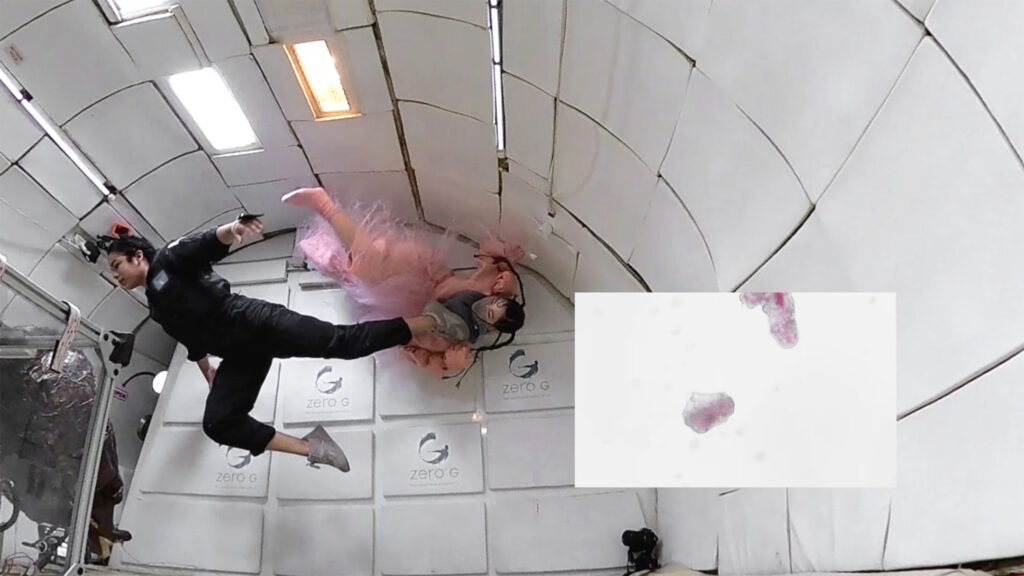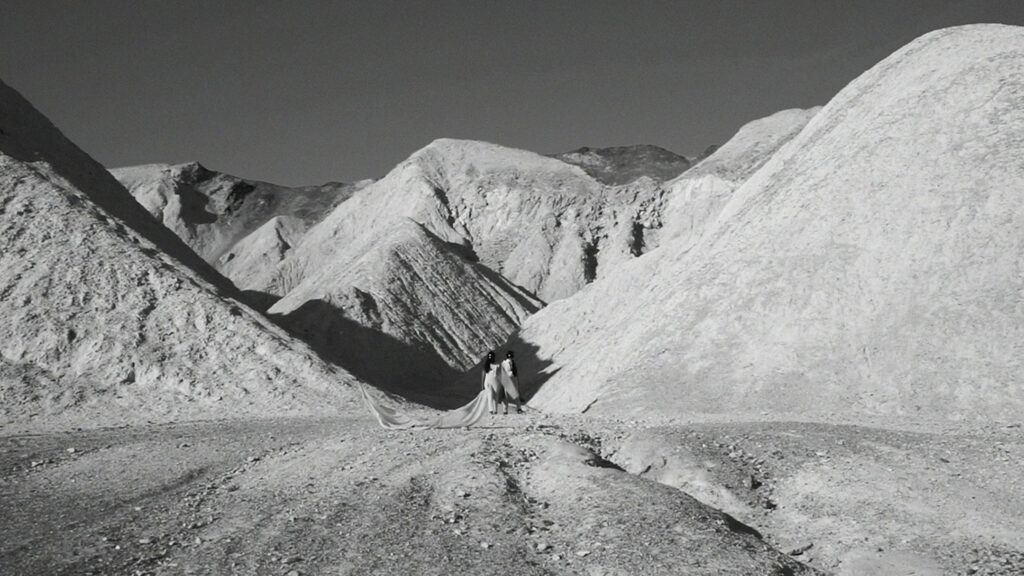Monday January 22 – Thursday January 25, 11pm PT
YES: Nancy Dayanne Valladares / HSURAE
Artists in attendance
In person and online

Microscope is very pleased to present the first 2024 edition of our emerging series YES with a screening of works by New York-based artists Nancy Dayanne Valladares and HSURAE.
The roughly 60-minute program of works by Valladares and HSURAE — who also collaborated on two of the videos — delve into the microbial universe that constitutes our existences, approached from the perspective of infinitesimal, often genderless, perpetually roaming organisms to which life, subject and object, time and space take on very different meanings than those we are accustomed to as humans.
In their videos, Valladares investigates forms of botanical exchange underlining the connections between plant transportation and colonial missions of the late 1700s and imagines what the seeds may have experienced during these transcontinental voyages through air and water. The Density of Breath is built upon the facts surrounding Captain’s Cook 1769 expedition to Tahiti, in which botanist Joseph Banks discovered breadfruit and its potential as inexpensive food for British slaves in the Caribbean. Recorded with a digital microscope, the work gradually reveals the indiscernible “bricks” of reality constituting every image around us — the paper fibers as substrate of text in a book page, the LED pixels of a video screen composing the image of a painting, the dense organic textures of a leave or human skin. Botanical Ghosts focuses on the death of botanist Dorothy Popenoe in Honduras in 1932 following the ingestion of the fruit of the ackee tree (Blighia Sapida), which was named after Captain Bligh who transported it from Jamaica to England in 1793. The video interweaves vivid shots of the tree with “a collection of letters, documents and images compiled over a period of 2 years” by the artist.
Driven by “the desire to become Other; non-human, trans-human, more-than-human, HSURAE’s Feline Intelligence provokes the viewer with the proposition of an interspecies fecal transplant between the artist and her cat, as a way to get closer to and better understand each other. The piece is based on the finding that flora in our guts affect our behavior and on the medical practice of fecal microbiota transplantation (FMT), which was used in China as early as the 4th century with a mixture of feces and saline, or “yellow soup.” Kombucha reveals the marvels and sensuality of bacterial cellulose — obtained through the fermentation of kombucha — aided by an entire set of cellulose whips and lingerie made, worn and handled by HSURAE. In this fire is in the belly of the beast, an electron microscope zooms in and out of fragments of burnt wood and burnt skin, hair, and bacteria, among others, while superimposed text addresses how memory does not only pertain to neurons but also plants and bacteria, and for humans “trying to capture a failing memory becomes an act of self definition.”
In Valladares and HSURAE’s collaborative project Panspermia — a title borrowed from the theory that seeds of life exist all over the universe and travel across it — the artists are seen floating in space in a simulated zero-gravity environment, resembling micro-organisms isolated and observed through a microscope. HSURAE, dressed in a pink “bio-designed flight suit,” proceeds to inhabit a bacterial cellulose sac in a symbiotic union.
3000 Years Among Microbes — a collaborative video work by Valladares, HSURAE and Chi Pohao — speculates on the origins and rebirths of worlds and the life that inhabits them, posing questions regarding “inter-planetary multi-species imaginaries.” Alternating black and white sequences of microscopic views with strikingly similar aerial shots of the artists walking through rocky terrains and other otherworldly locations, one cannot help but wonder what a 3000 year old microbe would have to say and why our presence on Earth is so short-lived.
Valladares and HSURAE will be available for a Q&A following the screening.
General In-person admission $10
Member & Students In-person admission $8
_
Nancy Dayanne Valladares (she/they) is an interdisciplinary artist, filmmaker and educator from Tegucigalpa, Honduras currently based in New York. Her image-based practice delves into the formation of optical tools and their accompanying visual regimes. Nancy’s practice closely examines photography’s historical entanglement with botanical imaginaries and chemical legacies.
HSURAE is a predisciplinary (artist, designer, researcher, educator) in the sense that each function is inseparable from the next, bracketed in consideration of the “pre-”. This prefix, the thing that comes before, the prefatory, is pre-reductive, is pre-particulate, is a generative field that they position their work within. Their artistic medium, like their self, is never pure object, never pure subject; ranging from hot glass to fibroblasts, passports to fecal sports. This agential infidelity renders itself visible at the mercy of metaphysics, science and technology studies, posthumanism, food studies, critical race studies and Traditional Chinese Medicine. Hsurae has been shown internationally, including: Taipei Fine Arts Museum, National Taiwan Museum of Fine Arts, MAXXI Rome, European Cultural Center, TORN theater space, Dubai BAIT15, Taipei Digital Art festival, Medialab Prado, Weisner gallery, Sakiya Palestine, Grand Siecle gallery, Yiri Art Gallery, Olfactory Keller NY amongst others. Artist residencies they’ve taken part in include SymbioticA, hangar.org, MedialabPrado, _V2 institute for the unstable media, Coalesce bioart lab and Urbanglass.

Still from “3000 Years Among Microbes” by Nancy Dayanne Valladares, HSURAE and Chi Pohao — Courtesy of the artists
Program:
The Density of Breath
By Nancy Dayanne Valladares
HD Video, color, sound, 2020, 13 minutes
Shot with an electronic microscope, The Density of Breath is a meditation on vegetal agency, plant exchanges and botanical representation. Millions of years after seeds learned to move in the currents of the ocean and the wind, to float on water and air, to become the first stowaways and hitchhikers, human colonial networks of exchange were strengthened as maritime travel developed. In pursuit of plant matter and the expansion of the human visual apparatus, technologies of plant transportation and representation marked a pivotal ecological and cognitive shift in various geographies around the globe. Self-titled naturalists and explorers like Alexander Von Humboldt became the de-facto authors of western botanical history. And yet, we know that history can be traced through other paths, agencies and lenses. What do seeds know about the flavor of the atmosphere; about the texture of the air and its currents, about its ebbs and flows?
Botanical Ghosts
By Nancy Dayanne Valladares
HD Video, color, sound, 2020, 10 minutes
otanical Ghosts is a three part project that traces the transatlantic voyage of the ackee tree (Blighia Sapida), and its encounter with British botanist Dorothy Popenoe at Lancetilla Botanical Experimental Station. Botanical Ghosts looks at histories of botanical representation, plant transportation, and their relationship to the legacies of colonial resource extraction in Honduras. The film follows a fictional exchange between Dorothy, the ackee fruit and the artist, as they pull on a thread that unravels the historical forces behind various encounters at Lancetilla. The Archive is a collection of letters, documents and images compiled over a period of 2 years that build on the timeline of Botanical Ghosts. This project was funded with the generous support of the Transmedia Storytelling Initiative, the Council of the Arts at MIT, the program in Art, Culture and Technology and the Harvard Film Studies Center.
Feline Intelligence
By HSURAE
HD video, color, sound, 2022, 6 minutes 6 seconds
Artificial Brain Loves to Watch Cat Videos. You’ll love the most when your favorite cat loves you, raises its head, and licks your lips. So you give your cat a chance and don’t let its fuzzy head get too close to its own scent. Now it can watch you and see what you’re doing. Now it can learn from you. //This paragraph was generated by an AI.
The desire to become Other. Non-human, trans-human, more-than-human. This desire is seductive, a primordial desire, arising from the soup of endosymbiosis. This desire is often framed as perverse, a taboo against the myth of the individual. In late capitalism it is not economical to understand that we are not in ourselves, we are through others. Always through others. Our agency is multitudinal and incommensurable. Our intelligence is distributed and collective. How do we model an intelligence that is not just machine learning to become brain? How do we develop othered kinds of intelligence?
Fire in the belly of the beast
By HSURAE
HD video, color, sound, 2019, 11 minutes
The following samples were imaged under a scanning electron microscope: Wildfire wood, burnt pine scale/mimosa pudica/skin and hair/paper with ink/bacteria/coal. This film is a meditation on the relationship between memory and fire. Just as matter becomes irrevocably undone by flames, memories exist in a state of constant departure. What connects fire and memory may be beyond metaphorical, and yet, a material relationship between immaterial matters can only be understood through the metaphor. Taking viewers on a “walk,” together we reflect on how both memory and fire involve processes of disappearance, transformation, and the enduring nature of what remains.
Kombucha
By HSURAE
HD video, color, sound, 2020, 5 minutes 21 seconds
This is a quintessential pandemic piece that emerged from the fermentation surge. Like countless others, I was engrossed in a fermenting frenzy during the lockdown. Simultaneously, I was writing my thesis and pouring over posthumanities text and scientific studies on the brain in the gut, our microbiomes. After many sleepless nights in the cacophony of bubbling airlocks on the meads and imploding glassware holding overactive wild yeast sodas, something peculiar transpired. Her name was Mi$stresS Kinship.
Panspermia
By Nancy Dayanne Valladares and HSURAE
HD video, color, sound, 2021, 4 minutes 41 seconds
This video is based off a performance that seeks to reframe imaginaries of multispecies survivance in space exploration via the lens of symbiosis. As a reformulation of the “first contact,” the narrative of the film shifts perspectives to a microbial scale. In contrast to Hollywood portrayals of alien first contact, here, first contact happens at a scale imperceptible to the unaided eye. The framing was inspired by biologist Lynn Margulis’ endosymbiotic theory of species evolution through a process described as “critters eating critters and getting indigestion.” The piece is an attempt to import the language of kinship into narratives of the interplanetary ecologies we might one day become part of.
3000 Years Among Microbes
By Nancy Dayanne Valladares, HSURAE, and Chi Pohao
HD Video, color, sound, 2021, 12 minutes
A narrative of kinship and symbiosis that begins with Djulis and its kindred. 3000 Years Among Microbes is a speculative project in collaboration with Rae Yuping Hsu, Chi Pohao, and Nancy Valladares, crossing between the domains of science fiction, generative sound, and filmmaking. In collaboration with artist, scientists, and researchers, it asks questions about space futures and inter-planetary multispecies imaginaries. Credits: 工作團隊 Team Artists |徐叡平 Rae Hsu 、紀柏豪 PoHao Chi、Nancy Valladares Supporting Artist |Chucho Ocampo CubeSat Installtion|陳湘馥 Hsiangfu Chen Aerial Photography Guide|Maggie Coblentz Supporting Photography|Ethan Kan, 張耀翔 Yaoxiang Zhang Project Mannager|賴慧珈 Caitlin Lai Administrate Support|陳旻靖 MinChing Chen Exhibition Design|賴慧珈 Caitlin Lai Visual Design|吳瑞桓 TRACY’S Web Design | 賴慧珈 Caitlin Lai Exhibition Executionm|詹若禾 RuoHe Jhan Project Consultant|Maggie Coblentz、Ariel Ekblaw、Danielle Wood Adviser|文化部 Ministry of Culture Organizer|新北市政府 New Taipei City Government Implementer|新北市政府文化局 Department of Cultural Affairs, Taipei City Government、新板藝廊 New Taipei Gallery Academic Cooperation|麻省理工學院藝術文化與科技所 MIT Program in Art, Culture, and Technology Special Thanks|國家太空中心 National Space Organization
